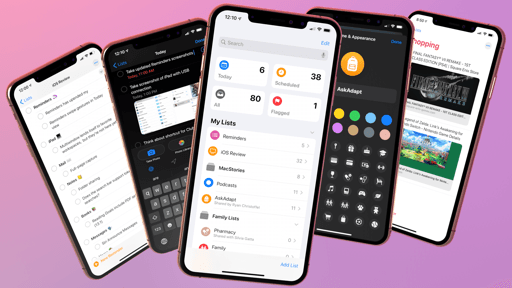Conclusion
When an iOS beta season wraps up and it’s time for millions of users to hit ‘Install’ on their iPhones and iPads, I always try to reflect on the overarching theme behind Apple’s latest software effort. To identify a single, all-encompassing idea – such as “iPad multitasking” in 2017 or “stability” in iOS 12 – that can put a nice bow on a new version of iOS and prepare us for future updates.
For the first time in years, I can’t pick a leitmotif that would adequately describe the magnitude of iOS and iPadOS 13. And maybe I don’t have to.
Most people will probably remember iOS 13 as another stepping stone in the evolution of Apple’s software design – the operating system that introduced dark mode and welcomed context menus in lieu of 3D Touch. Some will cherish the memory of Apple caving to critics and opening its file manager to external USB storage. Starting today, millions of iPhone users will find a new Shortcuts app on their Home screens and be exposed, likely for the first time in their lives, to the idea of automation and making a computer work for them. In a break with previous patterns, there is indeed something for everyone in iOS 13.
There’s an aura of intrigue about iOS 13’s atypical nature, which you can appreciate when analyzing iOS releases as more than mere software updates. They’re massive projects delivered at an unprecedented scale at once – millions of lines of code written by thousands of engineers, which are, somehow, delivered on time for an entire family of devices. Apple often misses a few marks, and iOS 13’s not perfect either: some of iOS 13’s best features won’t be available until iOS 13.1 (or later), and the system’s stability has somewhat suffered because of the sheer amount of new functionalities and tweaks. But in the meta discussion surrounding Apple’s software, controversies and unexpected features are also what make iOS 13 interesting and, from a reviewer’s perspective, more memorable than “safe” releases such as iOS 10 or iOS 12. I’m not justifying iOS 13’s shortcomings; I’m saying that even with its foibles, I can’t deny iOS 13’s got style.
Amidst a deluge of new features and design updates, iOS 13, more than its predecessors, makes clear that Apple doesn’t consider iOS just an operating system anymore: it’s the platform upon which the company can build other experiences. In a way, the modern iOS is to Apple devices what Mac OS X was to the original iPhone: a stable technological foundation, ready to be taken in new directions.
Nowhere is this more apparent than in the bifurcation of the platform with iPadOS. In older versions of iOS, there was always a palpable tension between the iPhone and iPad – a struggle to reconcile whether it was an “iPhone year” or “iPad year” for Apple’s software. That tension has been resolved by Apple in 2019 with the most obvious response: it’s the year of both.
With iOS and iPadOS officially separate, but united at the core, Apple was able to take what worked in the past and expand it for a device that doesn’t incur the same limitations as an iPhone. Desktop-class Safari and new Files integrations put the iPad on the same playing field as other tablets that can transform into laptops; multiwindowing, despite a few missteps, sticks the landing, blending the advantages of working on a Mac with the ingenuity of iOS. In all of this, Apple has found a satisfying balance between iOS and iPadOS, with key features shared between platforms (dark mode, Shortcuts, and Reminders, just to name a few) and plenty of attention specifically devoted to each. I don’t know if Apple will be able to keep their iPad momentum going on a regular schedule over the next few years; but today, I hope they can, and I want to believe they will.
By introducing iPadOS, Apple is selling us a bold future, one where the iPad can learn from the Mac’s lessons and play co-protagonist alongside the iPhone. And taken at face value, iPadOS delivers on what Apple promised back in June: more than any other iOS update before, iPadOS 13 has freed me from the constraints of desktop computing, turning my iPad experience into something that is neither iOS nor macOS, but different, audacious, and empowering.
As the curtain closes on the iPad’s first decade, whatever the future may hold, Apple has decided it’s time for the tablet to grow up, and is letting the iPad embark on its own adventure. Inspired by the Mac, firmly grounded in iOS’ tradition, and unafraid of what’s next.















